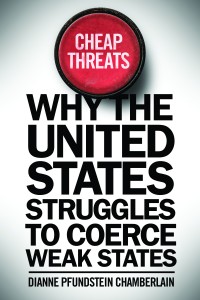 It’s here! My first book, Cheap Threats: Why the United States Struggles to Coerce Weak States is now available for purchase through Georgetown University Press and Amazon. The book focuses on the following puzzle: The United States has the world’s most powerful military and has demonstrated a willingness to use its military power on many occasions (in fact, the book demonstrates that the United States always follows through on its compellent threats[1]). Why, then, would a small, weak state choose not to comply when the United States threatens it with military force to try to convince it to change its behavior? In other words, when the United States says to a weak state, “admit weapons inspectors to your nuclear facilities or we will bomb you,” why would this state choose to resist?
It’s here! My first book, Cheap Threats: Why the United States Struggles to Coerce Weak States is now available for purchase through Georgetown University Press and Amazon. The book focuses on the following puzzle: The United States has the world’s most powerful military and has demonstrated a willingness to use its military power on many occasions (in fact, the book demonstrates that the United States always follows through on its compellent threats[1]). Why, then, would a small, weak state choose not to comply when the United States threatens it with military force to try to convince it to change its behavior? In other words, when the United States says to a weak state, “admit weapons inspectors to your nuclear facilities or we will bomb you,” why would this state choose to resist?
In Cheap Threats, I draw on game theoretic logic about costly signaling to argue that target states resist compellent threats issued by the United States when these threats are cheap to issue and to execute. I demonstrate that the United States has developed a method of war-fighting that limits the costs (human, financial, and political) of employing military force, and thus the threat to employ force is not a convincing signal that the United States is highly motivated to exact compliance from the targeted state. In other words, targets resist in the face of threats that are relatively cheap to execute because the cheapness of the force does not signal that the United States is highly motivated. A target expects that the United States will carry out the threatened action and then give up as the costs of continuing to coerce the target state become too high.
How can I argue that the use of force is cheap for the country with the world’s most expensive defense establishment? Cheap Threats demonstrates that the United States now has a model of warfare that relies on an all-volunteer military (no politically costly conscripts to send overseas) supplemented by private contractors who rely on advanced technology to attack targets from a distance (precision air power and drones, for example), and that we pay for our wars (Iraq and Afghanistan) with deficit spending. We have effectively insulated the vast majority of the American public from the costs of employing force, and we even shield our own soldiers from many of these costs by opting for “standoff strike” operations like we saw with the 2011 Libya intervention, which was conducted entirely from the skies.[2]
To make the case for my theory, I evaluate an original dataset of compellent threats in all international crises in which the United States was involved from 1945-2007. I also examine in detail four prominent cases in which the United States employed threats to coerce an adversary: the 1962 Cuban Missile Crisis, the 1991 Gulf War, the 2003 War against Iraq, and the 2011 Libya intervention. The Iraq chapters draw on new caches of documents and recordings seized after the 2003 invasion of Iraq to probe Saddam Hussein’s decision making (spoiler alert: he’s not as crazy as you might have thought!), and the Libya chapter traces the course of the U.S. decision to intervene and Qaddafi’s continued resistance. I also take a look at many competing arguments about threat effectiveness. I find, for example, no support for the argument that states determine whether to comply with threats based on the United States’ reputation for acting in past crises. In other words, the United States does not need to take action simply for the purpose of reinforcing a reputation for toughness.
Need more convincing? Read reviews of the book and see a list of contents here.
[1] A “compellent threat” involves the use of a threat of military force to convince a targeted state to change its current behavior. A “deterrent threat,” on the other hand, is a threat intended to prevent future behavior (nuclear deterrence would fall into this general category). Cheap Threats focuses only on compellent threats.
[2] The book explains why the costs that the United States incurs when issuing and executing threats, not those incurred by the target, make a threat effective in changing a target’s behavior.
